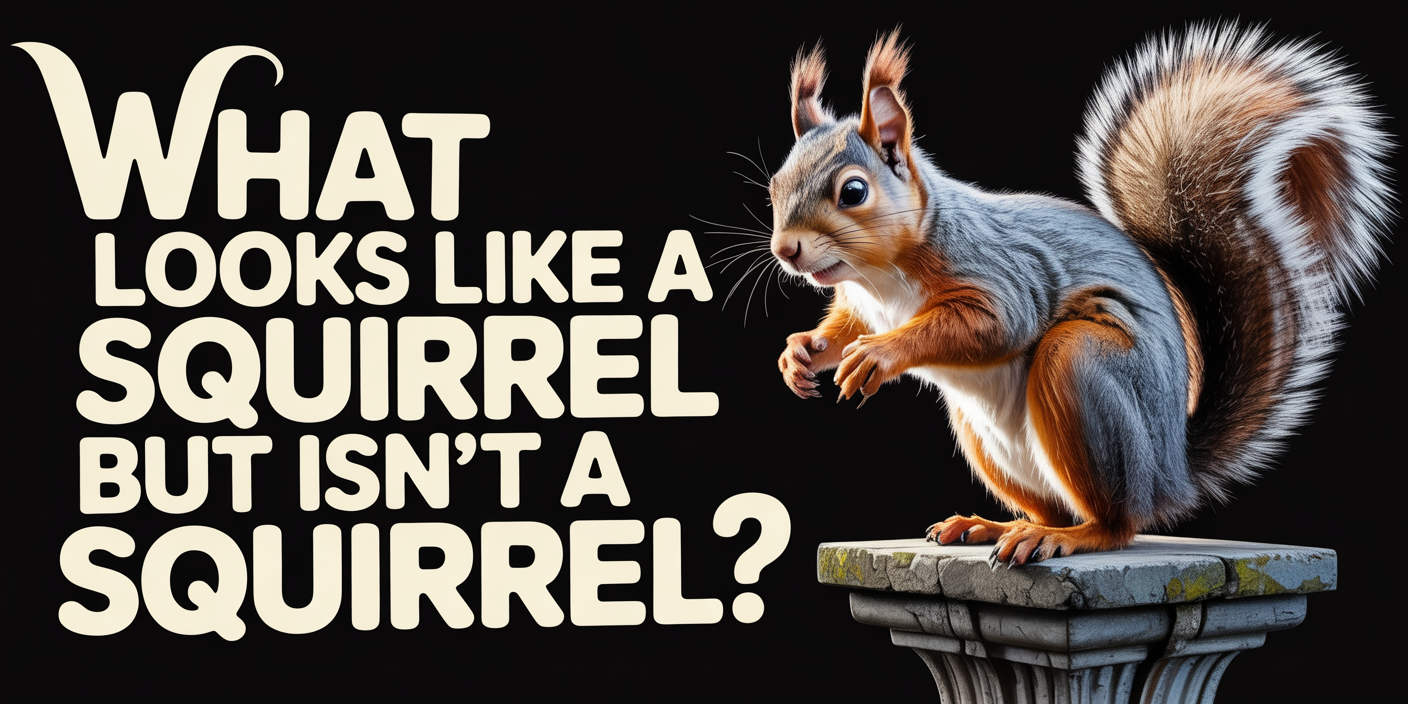Many animals share similar features with squirrels, such as chipmunks, marmots, and tree shrews. While they may resemble squirrels in size, shape, and behavior, they differ in tail structure, habitat, and social habits.
Squirrels are some of the most recognizable creatures in parks and backyards, but did you know that other animals can look strikingly similar to them? From the tiny chipmunk to the larger marmot, many animals share features that might make you do a double-take—so let’s dive into which critters are often mistaken for squirrels and how to tell them apart!
Why Do We Mistake Other Animals for Squirrels?
Humans often confuse animals that share similar physical characteristics, and squirrels are no exception. With their bushy tails, small size, and agile movements, many other creatures mimic these traits. These lookalikes often inhabit similar environments, like forests and parks, making it easy to mistake them for squirrels, especially when they’re darting across the ground or climbing trees. The visual similarities, combined with their often similar behaviors, create the perfect recipe for confusion.
Additionally, many of these animals have evolved in ways that help them thrive in similar ecological niches. For example, animals like chipmunks and prairie dogs have adapted to living in burrows or tree trunks, much like squirrels. Their ability to quickly scurry around in search of food or escape from predators further adds to the confusion. The similarities aren’t just in appearance; they often mimic the behaviors that make squirrels so iconic, from gathering food to socializing in groups.
Animals That Look Like Squirrels
Chipmunks
Chipmunks are one of the most common animals that people mistake for squirrels. They are small, agile rodents with a similar body shape and size, making them easy to confuse with squirrels. The key difference, however, lies in their fur pattern—chipmunks are known for their distinctive striped coats, with alternating dark and light stripes running down their backs. While squirrels have more uniform fur, these stripes are an unmistakable feature of chipmunks that sets them apart. Additionally, chipmunks tend to be ground dwellers and are often seen foraging along the forest floor, unlike squirrels that spend more time in trees.
Marmots
Marmots, often confused with ground squirrels, are larger rodents that also resemble squirrels in body shape and size. However, marmots are much bulkier and are typically found in open fields or mountainous regions rather than forests. They are social animals, often living in colonies and making extensive burrows, which contrasts with the more solitary, tree-dwelling habits of squirrels. Marmots also have shorter tails and a more stout body, distinguishing them from their sleeker squirrel cousins. While both marmots and squirrels can be seen foraging for food, their size and habitat preferences are key clues to tell them apart.
Prairie Dogs
Prairie dogs are another rodent that often gets mistaken for squirrels, especially due to their burrowing habits and social behavior. While prairie dogs are similar in size and shape, they differ in one important way: their community structure. Prairie dogs live in large colonies and are highly social, often seen in groups standing alert together, keeping an eye out for predators. In contrast, squirrels, while they may gather in groups during certain seasons, are typically more solitary and prefer living in trees. Prairie dogs have shorter, more rounded tails and spend most of their time on the ground, unlike squirrels, which are more agile climbers.
Flying Squirrels
Flying squirrels are another creature that often causes confusion, despite technically being a type of squirrel. They share many physical traits with tree squirrels, including their small size, big eyes, and bushy tails. However, what sets them apart is their ability to glide. Flying squirrels have a membrane of skin between their limbs that allows them to glide from tree to tree, a feature that regular squirrels do not possess. While they still belong to the squirrel family, their nocturnal habits and gliding abilities are stark differences from the typical tree squirrel’s daily routine and energetic daytime activity.
Tree Shrews
Though not directly related to squirrels, tree shrews share several similarities that often lead to confusion. These small, agile mammals resemble squirrels in their body shape, size, and tree-dwelling habits. However, unlike squirrels, tree shrews are part of a different order altogether and belong to the family Tupaiidae. They are more closely related to primates than rodents, which is a significant distinction. Tree shrews also have smaller, more delicate tails compared to squirrels’ bushy tails. While both animals are seen scampering through the trees in search of food, tree shrews tend to have a more slender appearance and can be identified by their smaller, pointier faces.
Other Rodents
Aside from the more commonly mistaken animals, there are several other rodents that might bear a resemblance to squirrels. Groundhogs, for example, are larger and more stocky than squirrels, but their burrowing behavior and similar face structure can sometimes lead to confusion. Additionally, rats, particularly those with bushy tails like the Norway rat, might be misidentified as squirrels from a distance. However, rats are typically much larger and bulkier, with a thinner, scaly tail compared to the thick, fur-covered tails of squirrels. Despite the similarities, the size and shape differences between these rodents and squirrels are usually noticeable once a closer look is taken.
How to Tell the Difference
Size and Shape
One of the easiest ways to differentiate between squirrels and their lookalikes is by size. Squirrels are typically small to medium-sized rodents, with most species measuring between 9 to 12 inches long, not including their tails. In comparison, marmots and prairie dogs tend to be bulkier and larger, often measuring up to 20 inches in length. A larger size combined with a more rounded or stocky body is a strong indication that you’re looking at a marmot or prairie dog rather than a squirrel. Chipmunks, on the other hand, are much smaller than squirrels and usually only measure 4 to 6 inches in body length, making them easy to distinguish by their petite frame.
Tail Comparison
Another key indicator that can help you tell the difference is tail structure. Squirrels are known for their large, bushy tails, which they use for balance when climbing and as a tool for communication. The bushiness of their tails is a distinct feature that sets them apart from other rodents like prairie dogs or marmots, which have much shorter or less fluffy tails. Chipmunks also have tails, but they are noticeably smaller and not as bushy as a typical squirrel’s tail. Flying squirrels have a unique membrane between their legs that allows them to glide, but their tails are similarly bushy, though slightly smaller compared to tree squirrels. Therefore, when observing an animal, pay attention to the fullness and fluffiness of its tail for a quick clue.
Behavioral Differences
Behavior is another major factor in distinguishing squirrels from their lookalikes. Squirrels are highly agile, fast-moving animals that are often seen darting up trees or foraging on the ground for food. If you spot an animal actively climbing or jumping between trees, chances are it’s a squirrel. On the other hand, prairie dogs and marmots, which are more terrestrial, spend much of their time on the ground, often in burrows or open fields. These animals are not as quick to climb trees, making them easier to identify in areas where tree-dwelling rodents are common. Additionally, prairie dogs are often seen in groups, standing on their hind legs to watch for predators, which is quite different from the solitary behavior of most squirrel species.
Habitat Preferences
The habitat you find an animal in can provide valuable clues as well. Squirrels tend to live in wooded areas, forests, and urban parks, where they make their nests in trees, often in hollow trunks or nests made of twigs. If you spot an animal living in a burrow on the ground or in open fields, it’s more likely to be a prairie dog or marmot. Marmots, in particular, prefer mountainous areas and rocky hillsides, while prairie dogs are usually found in grasslands or open plains. Flying squirrels, meanwhile, are more likely to be found in dense forests, particularly at night, as they are nocturnal. Understanding an animal’s preferred habitat can significantly aid in identifying whether it’s a squirrel or another similar creature.
Keep Your Home Squirrel-Free with AAAC Wildlife Removal
If you’re tired of dealing with pesky squirrels or other wildlife making a home in your attic or yard, AAAC Wildlife Removal is here to help! Our team of experts is ready to safely and effectively remove any unwanted critters from your property and ensure that they don’t come back. We offer humane removal services, thorough inspections, and long-term prevention strategies to protect your home.
Don’t wait for the damage to get worse—contact AAAC Wildlife Removal today to schedule a free inspection! Let us help you create a safe, squirrel-free environment for you and your family.
Conclusion
In conclusion, while many animals share characteristics with squirrels, the subtle differences in size, tail structure, behavior, and habitat can help you distinguish them. From chipmunks and marmots to prairie dogs and flying squirrels, each of these creatures has its own unique traits that set them apart from true squirrels. The next time you spot one of these lookalikes, take a moment to examine its behavior, size, and surroundings—chances are, you’ll be able to tell whether it’s a squirrel or a similar critter in disguise.
Understanding the differences between these animals not only satisfies curiosity but also enhances your ability to identify the wildlife around you. So, keep an eye out for these fascinating creatures in your backyard, at the park, or during a hike. You’ll be amazed at how many lookalikes there are in the animal kingdom, and with these tips in mind, you’ll never mistake a marmot for a squirrel again!




